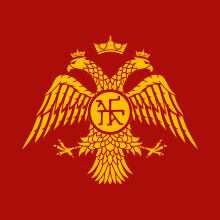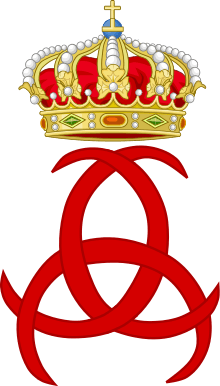Royal cypher

In modern heraldry, a royal cypher is a monogram-like device of a country's reigning sovereign, typically consisting of the initials of the monarch's name and title, sometimes interwoven and often surmounted by a crown.[1] In the case where such a cypher is used by an emperor or empress, it is called an imperial cypher. In the system used by various Commonwealth realms, the title is abbreviated as R for rex or regina (Latin for king and queen). Previously, I stood for imperator or imperatrix (Latin words for emperor and empress) of India.[2][3] The cypher is displayed on some government buildings, impressed upon royal and state documents, and is used by government departments.
Commonwealth realms
The use of a royal cypher in the Commonwealth realms originates in the United Kingdom, where the public use of the royal initials dates at least from the early Tudor period, and was simply the initial of the sovereign with, after Henry VIII's reign, the addition of the letter R for Rex or Regina. The letter I for Imperatrix was added to Queen Victoria's monogram after she became Empress of India in 1877. The initials—which had no set pattern or form of lettering laid down— were usually shown in company with the royal arms or crown as on the king's manors and palaces—such as those of Henry VIII on the gatehouse of St James' Palace. The purpose seems to have been simply to identify an individual sovereign, as the royal coat of arms was often used by successive monarchs. The initials were used mostly on government papers, duty stamps and similar objects, and were sometimes surmounted by a stylised version of the Tudor Crown or, more recently, St Edward's Crown. In Scotland, the Crown of Scotland appears in place of the Imperial Crown.[4]
Though royal symbols differ among the sixteen Commonwealth realms, as they are separate monarchies, the one sovereign uses the same cypher throughout all of his or her countries. Distinction continues to be made between the personal cypher and the simpler, more workaday public initials, the former being the sovereign's own monogram and the latter simply a means of identifying a reign. Nowadays, the initials are also called the royal cypher, but, to aid clarification, the monogram is referred to as the royal cypher interlaced and reversed.
The present Queen's cypher is EIIR, standing for Elizabeth II Regina. Cyphers for other members of the Royal Family are designed by the College of Arms or Court of the Lord Lyon and are subsequently approved by the Queen. These cyphers have been incorporated by the Canadian Heraldic Authority into the various royal standards of Canada. The use in Canada of the reigning monarch's cypher, which is sometimes uniquely surrounded by a garland of maple leaves, is as a symbol not only of the sovereign him or herself, but of Canada's full sovereignty as well.[5]
Elsewhere
Other royal houses have also made use of royal or imperial cyphers. Ottoman sultans had a calligraphic signature, their tughra.
All the monarchs of Europe's six other surviving kingdoms use cyphers, with royal crowns above them. Harald V of Norway uses the letter H crossed with the Arabic numeral 5; Carl XVI Gustav of Sweden uses the letters C and G overlapping with the Roman numeral XVI below them; and Margrethe II of Denmark uses the letter M with the Arabic numeral 2 and the letter R (for Regina) below it. Philippe of Belgium uses the letters P and F intertwined, referring to the fact that his name is Philippe in French, but Filip in Dutch, the two main languages in Belgium.
The late King Bhumibol Adulyadej of Thailand uses a cypher made up of his initials in Thai script ("ภ.ป.ร.").
Gallery
 The double-headed eagle, the most recognized emblem of the Byzantine Empire, with the sympilema (dynastic cypher) of the Palaeologi in the centre
The double-headed eagle, the most recognized emblem of the Byzantine Empire, with the sympilema (dynastic cypher) of the Palaeologi in the centre The arms of the Kingdom of Prussia including the cypher of King Friedrich I of Prussia at the centre.
The arms of the Kingdom of Prussia including the cypher of King Friedrich I of Prussia at the centre.
- Cypher of King Geórgios I of the Hellenes on the Order of Geórgios I
 The cypher of King George II of Great Britain and Ireland, employing an Arabic numeral 2.
The cypher of King George II of Great Britain and Ireland, employing an Arabic numeral 2. The Royal and Imperial Cypher of Queen Victoria forms a part of the emblem of the Royal Victorian Order surrounded by a Brunswick star
The Royal and Imperial Cypher of Queen Victoria forms a part of the emblem of the Royal Victorian Order surrounded by a Brunswick star- The Royal Cypher of King Edward VIII; as with all cyphers before Queen Elizabeth II, it uses the Tudor Crown above the lettering
 The most common variant of George VI's cypher
The most common variant of George VI's cypher The Royal Cypher of Queen Elizabeth II, surmounted by St Edward's Crown
The Royal Cypher of Queen Elizabeth II, surmounted by St Edward's Crown A variant of the cypher of Queen Elizabeth II in Jersey, showing an Arabic numeral 2 as opposed to the Roman II typically employed
A variant of the cypher of Queen Elizabeth II in Jersey, showing an Arabic numeral 2 as opposed to the Roman II typically employed
 The monogram of Charles III of Brabant is uncommon in its pattern and triple repetition of his initial.
The monogram of Charles III of Brabant is uncommon in its pattern and triple repetition of his initial.
See also
| Wikimedia Commons has media related to Royal monograms. |
References
- ↑ The Shorter Oxford English Dictionary (Fifth edition; 2002), Volume 1, p. 1820.
- ↑ Morley, Vincent. "United Kingdom: Royal Navy". Flags Of The World. Retrieved 30 October 2009.
- ↑ Boutell, Charles; Wheeler-Holohan, V. (1931). Boutell's Manual of Heraldry. Detroit: F. Warne and Co. Ltd. p. 244. Retrieved 30 October 2009.
- ↑ Boutell, Charles; Fox-Davies, A.C. (21 July 2008). The Handbook to English Heraldry. Echo Library. ISBN 978-1-4068-2770-5.
- ↑ MacLeod, Kevin S. (2008), A Crown of Maples (PDF) (1 ed.), Ottawa: Queen's Printer for Canada, p. 61, ISBN 978-0-662-46012-1, retrieved 21 June 2009